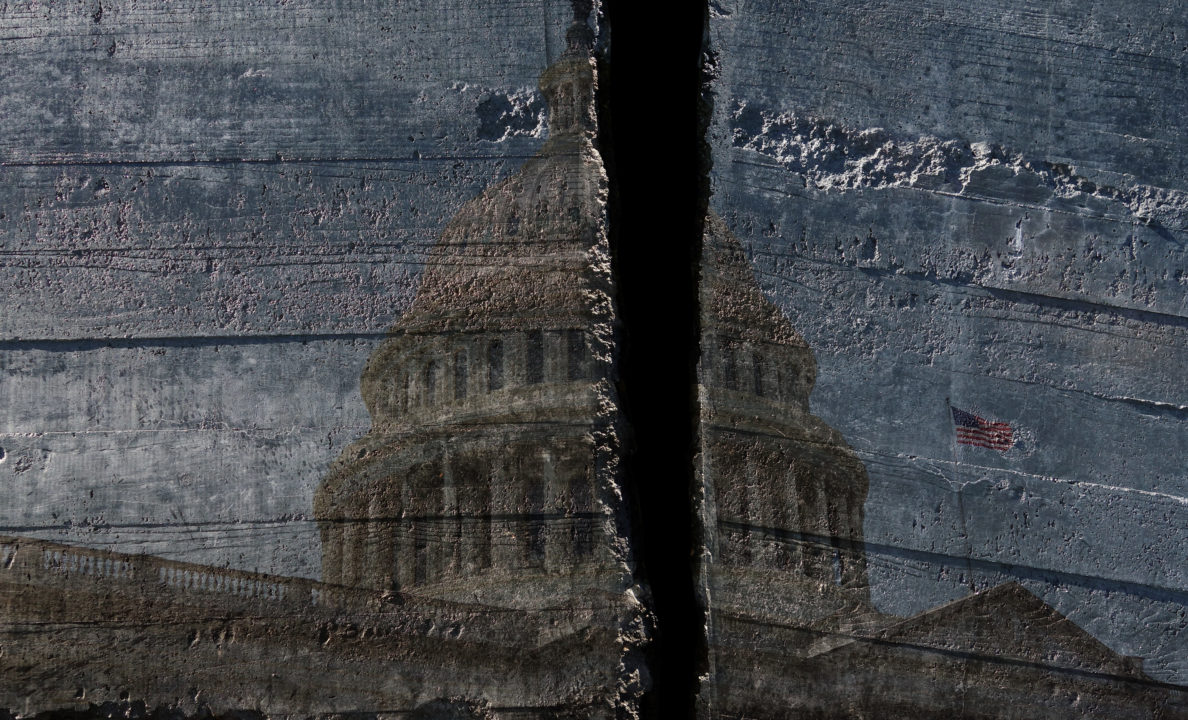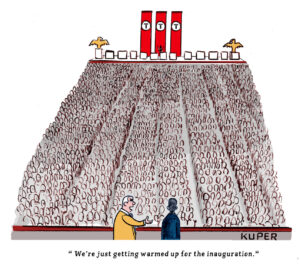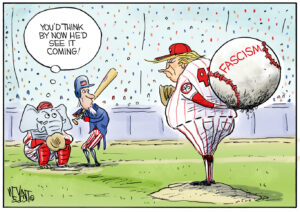Democracy on the Ballot
The stakes of tomorrow’s election could not be higher. Zimmytws / Adobe Stock Photos
Zimmytws / Adobe Stock Photos
2023 Southern California Journalism Award: First Place, Election Editorials
If the Republicans take back either the House or Senate tomorrow, the stage will be set for Donald Trump’s return in 2024. If that happens, there will be few, if any, guardrails left to preserve what is left of our damaged and fraying democracy.
Since 2016, the MAGA movement Trump leads has morphed from a retrograde white nationalist crusade to a full-blown neo-fascist force. This fact will become all-too apparent in a MAGA Congress led by Marjorie Taylor Greene, Lauren Boebert and Paul Gosar on the House side, and Ron Johnson, Josh Hawley and Ted Cruz in the upper chamber. Think of a media landscape dominated by an ascendant Steve Bannon and Breitbart as the MAGA movement drowns out what few dissident voices remain within the GOP.
Fascism is a loaded term, but if used correctly, it applies to Trumpism.
All that is on the line tomorrow. And don’t count on the courts if Trump returns to power. The legal system, already infested by jurists hand-picked by the Federalist Society, will offer fewer and fewer safeguards as the movement undertakes to dismantle Social Security, Medicare, civil rights, environmental protection, trade-union rights, women’s rights and all vestiges of what it derisively refers to as the “administrative state.”
We are at an inflection point in our history where the choice confronting us is one between democracy — with all of its frailties and shortcomings — and a renewed and revitalized fascism.
Fascism is a loaded term, but if used correctly, it applies to Trumpism.
In his seminal study, “The Anatomy of Fascism,” Robert Paxton defined fascism as a “form of political behavior marked by obsessive preoccupation with community decline, humiliation or victimhood and by compensatory cults of unity, energy and purity, in which a mass-based party of committed nationalist militants, working in uneasy but effective collaboration with traditional elites, abandons democratic liberties and pursues with redemptive violence and without ethical or legal restraints goals of internal cleansing and external expansion.”
Trump and Trumpism similarly embody the 14 common factors of fascism identified by the great Italian writer Umberto Eco in his 1995 essay, “Ur Fascism”:
- A cult of traditionalism.
- A rejection of modernism (cultural, rather than technological).
- A cult of action for its own sake and a distrust of intellectualism.
- A framing of disagreement or opposition as treasonous.
- A fear of difference. Fascism is racist by definition.
- An appeal to a frustrated middle class — either due to economic or political pressures from both above and below.
- An obsession with the plots and machinations of the movement’s identified enemies.
- A requirement that said enemies be simultaneously seen as omnipotent and weak, conniving and cowardly.
- A rejection of pacifism. Life is permanent warfare.
- Contempt for weakness.
- A cult of heroism.
- Hypermasculinity.
- A selective populism, relying on chauvinist definitions of “the people” that it claims to speak for.
- A heavy usage of Newspeak — impoverished vocabulary, elementary syntax and a resistance to complex and critical reasoning.
As the current situation demonstrates, fascism is by no means a foreign phenomenon restricted to South American banana republics or failed European states. As University of London professor Sarah Churchwell explained in a June 22, 2020 essay published in the New York Review of Books, fascism has deep roots in the United States, starting with the resurgence of the Ku Klux Klan in the 1920s and extending to the rise of the German-American Bund in the 1930s to the ascendance of Depression-era demagogues like Huey Long, and the election of Trump in 2016.
Churchwell’s article is fittingly titled, “American Fascism: It Has Happened Here.” In it, she offers yet another working definition of fascism, noting that while fascist movements differ from nation to nation, they are united by “conspicuous features [that] are recognizably shared.” These include:
“[N]ostalgia for a purer, mythic, often rural past; cults of tradition and cultural regeneration; paramilitary groups; the delegitimizing of political opponents and demonization of critics; the universalizing of some groups as authentically national, while dehumanizing all other groups; hostility to intellectualism and attacks on a free press; anti-modernism; fetishized patriarchal masculinity; and a distressed sense of victimhood and collective grievance. Fascist mythologies often incorporate a notion of cleansing, an exclusionary defense against racial or cultural contamination, and related eugenicist preferences for certain ‘bloodlines’’ over others.”
No one has summarized the perils of Trumpism with more insight than the celebrated linguist and political commentator Noam Chomsky. In a June 2021 interview with Truthout, Chomsky remarked:
“The term ‘neoliberal proto-fascism’ captures well both the features of the current [Republican] party and the distinction from the fascism of the past. The commitment to the most brutal form of neoliberalism is apparent in the legislative record, crucially the subordination of the party to private capital, the inverse of classic fascism. But the fascist symptoms are there, including extreme racism, violence, worship of the leader (sent by God, according to former Secretary of State Mike Pompeo), immersion in a world of ‘alternative facts’ and a frenzy of irrationality.”
In light of the looming election, it is worth recalling a searing 2016 column by Adolph Reed Jr., in which the renowned political scientist urged readers to “Vote for the Lying Neoliberal Warmonger: It’s Important.” Reed argued that the dangers of allowing Donald Trump to win the presidency were so great, the American left had no choice but to hold its collective nose and keep Trump out of office by voting for Hillary Clinton, a politician Reed plainly despised.
To drive home his message, Reed cited an article written by Harold Meyerson for the American Prospect, in which Meyerson compared the political climate of 2016 in the United States to Germany in the early 1930s. As the Nazi Party gained strength those many decades ago, the Communist Party, led by Ernst Thalmann, refused to join forces with the liberal and weak Social Democrats against Hitler, believing the Social Democrats to be a greater threat to the working class than the fascists.
We all know too well what tragedies followed. So do your part, and vote.
Your support is crucial…With an uncertain future and a new administration casting doubt on press freedoms, the danger is clear: The truth is at risk.
Now is the time to give. Your tax-deductible support allows us to dig deeper, delivering fearless investigative reporting and analysis that exposes what’s really happening — without compromise.
Stand with our courageous journalists. Donate today to protect a free press, uphold democracy and unearth untold stories.






You need to be a supporter to comment.
There are currently no responses to this article.
Be the first to respond.